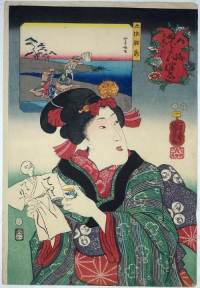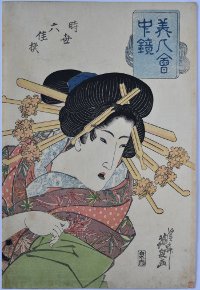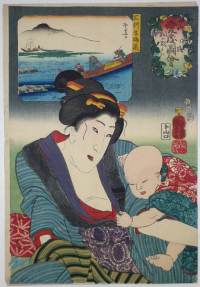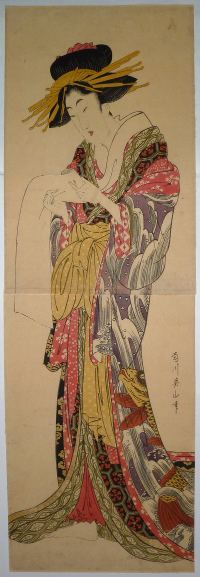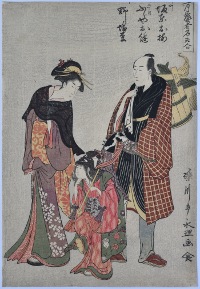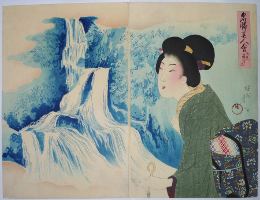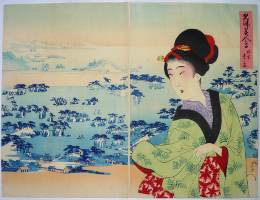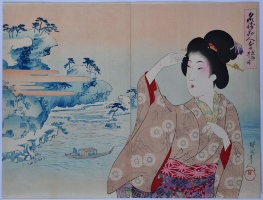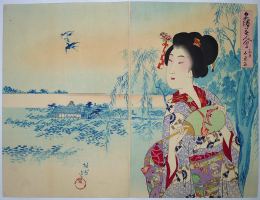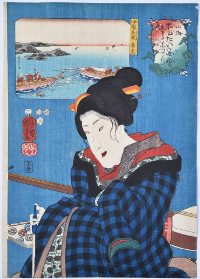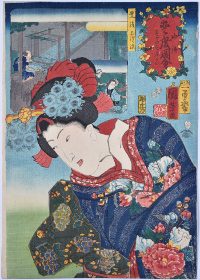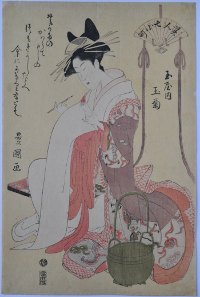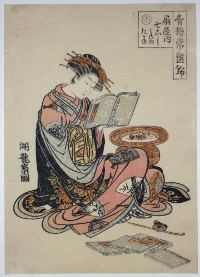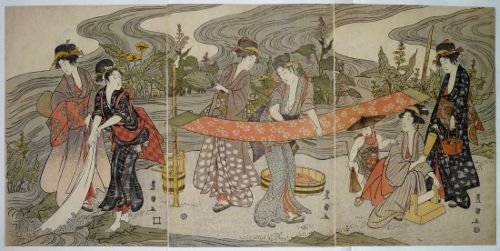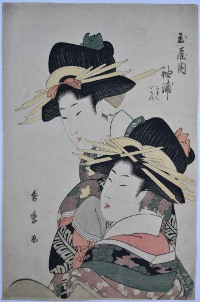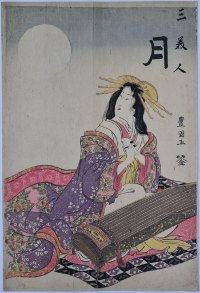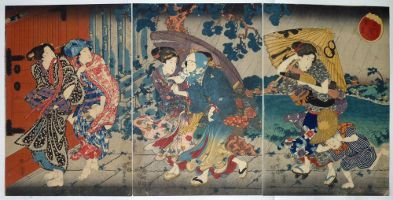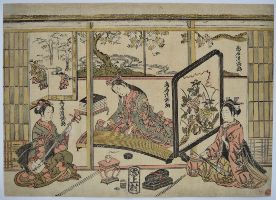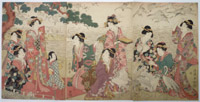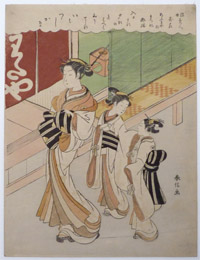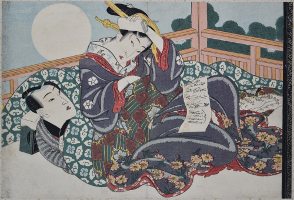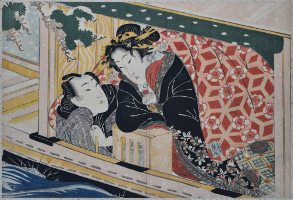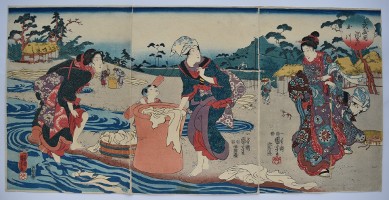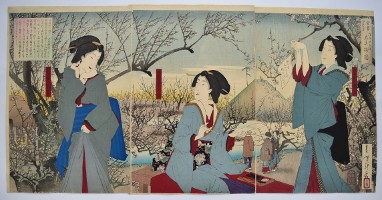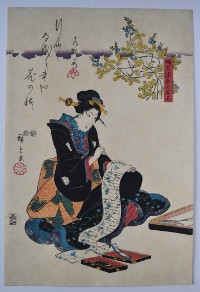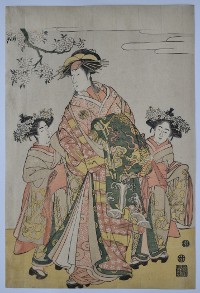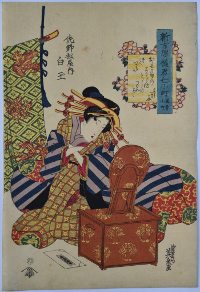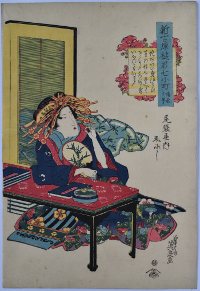/category/archive/page/44/
Utagawa KUNIYOSHI (1797-1861)
Click here to view image full size.
A beauty in sumptuous clothing from a fine set of seventy numbered prints with title: Sankai medetai zu, “Excellences of Mountain and Sea.” The set compares busts of beautiful women with various products and occupations from the provinces of Japan. The inset view here shows dried bonito from Tosa Province, Tosa katsuobushi. The set published 1852 by Sano-ya Kihei.
Superb impression, very fine colour and condition. Signed Ichiyusai Kuniyoshi ga.
Status: Sold
Keisai EISEN (1790-1848)
Click here to view image full size.
A high-ranking courtesan ( oiran ) looking over her shoulder. From a set of six prints: Bijin kaichu kagami – Jisei rokkassen: Ariwara no Narihira, “ A Pocket Mirror of Beauties – Six Immortal Poets of the Era: Ariwara no Narihira.” The set compares the beauties to the six “immortal” waka poets of the 9th/10th centuries. The maple leaves on the oiran’s collar identify the subject as compared to the poet Ariwara no Narihira ( 825-880 A.D. ). The set published by Senichi, c 1826-28.
Fine early impression. Fine colour. Very slight soil and trimming bottom right, otherwise fine condition. Signed Keisai Eisen ga.
Status: Sold
Utagawa KUNIYOSHI (1797-1861)
Click here to view image full size.
A beauty in sumptuous clothing from a fine set of seventy numbered prints with title: Sankai medetai zu, “Excellences of Mountain and Sea.” The set compares busts of beautiful women with various products and occupations from the provinces of Japan. The inset view here shows sea cucumber being collected in Mikawa Province, Mikawa-namako. The set published 1852 by Sano-ya Kihei.
Superb impression, very fine colour and condition. Signed Ichiyusai Kuniyoshi ga.
Status: Sold
Kikugawa EIZAN (1787-1867)
Click here to view image full size.
A fine kakemono of a standing beauty reading. The perfectly preserved colours on this print allow us to fully appreciate her elaborate garments.
Fine impression. Very fine colour. Fine condition. Full size. Signed Toshinobu Eizan hitsu.
Status: Sold
Shikyusai EIRI (Fl c 1790-1800)
Click here to view image full size.
The courtesan Bando Oume of the Hasegawa-cho with the boy No Shiomatsu and O-tsui of Fujiya from a set Furyu juni-gatsu geisha meimyo awase, “Elegant Twelve Months Showing Various Famous Geisha.” Possibly New Year on the way to Niwaka festivities. Published by Yama-cho, c 1790-1800. A rare design by a rare artist. Possibly a pupil of Eishi.
Fine impression and colour. Exceptional retention of the pigments. Trimmed at the top, otherwise very good condition. Signed Rekisentei Eiri ga.
Status: Sold
Toyohara CHIKANOBU (1838-1912)
Click here to view image full size.
A fine set of diptychs showing beauties compared to scenic places in Japan. Meisho bijin awase, “Comparison of Famous Places and True Beauties.” In this instance the Kirifuri waterfall in Nikko Province. The unusual backgrounds are printed in blue with touches of pink. The set published by Matsuki Heikichi, 1897-8.
Fine impression, color and condition. Signed Yoshu Chikanobu.
Status: Sold
Toyohara CHIKANOBU (1838-1912)
Click here to view image full size.
A fine set of diptychs showing beauties compared to scenic places in Japan. Meisho bijin awase, “Comparison of Famous Places and True Beauties.” In this instance Matsushima in Rikuzen Province. The unusual backgrounds are printed in blue with touches of pink. The set published by Matsuki Heikichi, 1897-8.
Fine impression, color and condition. Signed Yoshu Chikanobu.
Status: Sold
Toyohara CHIKANOBU (1838-1912)
Click here to view image full size.
A fine set of diptychs showing beauties compared to scenic places in Japan. Meisho bijin awase, “Comparison of Famous Places and True Beauties.” In this instance Sozumegaura in Musashi Province. The unusual backgrounds are printed in blue with touches of pink. The set published by Matsuki Heikichi, 1897-8.
Fine impression, color and condition. Signed Yoshu Chikanobu.
Status: Sold
Toyohara CHIKANOBU (1838-1912)
Click here to view image full size.
A fine set of diptychs showing beauties compared to scenic places in Japan. Meisho bijin awase, “Comparison of Famous Places and True Beauties.” In this instance showing Shinobazu Pond in Ueno Park. The unusual backgrounds are printed in blue with touches of pink. The set published by Matsuki Heikichi, 1897-8.
Fine impression, color and condition. Signed Yoshu Chikanobu.
Status: Sold
Utagawa KUNIYOSHI (1797-1861)
Click here to view image full size.
A beauty in sumptuous clothing from a fine set of seventy numbered prints with title: Sankai medetai zu, “Excellences of Mountain and Sea.” The set compares busts of beautiful women with various products and occupations from the provinces of Japan. The inset view here shows octopus from Iyo Province, Iyo nagahama no tako. The set published 1852 by Sano-ya Kihei.
Superb impression, very fine colour and condition. Signed Ichiyusai Kuniyosh
Status: Sold
Utagawa KUNIYOSHI (1797-1861)
Click here to view image full size.
A beauty in sumptuous clothing from a fine set of seventy numbered prints with title: Sankai medetai zu, “Excellences of Mountain and Sea.” The set compares busts of beautiful women with various products and occupations from the provinces of Japan. The inset view here shows woven silk from Bungo Province, Bungo shiborizone. The set published 1852 by Sano-ya Kihei.
Superb impression, very fine colour and condition. Signed Ichiyusai Kuniyosh
Status: Sold
Utagawa TOYOKUNI I (1769-1825)
Click here to view image full size.
Shows Tamagiku of the House of Tama from the extremely rare set of seven prints Bijin nanakomachi, “Beauties of the Seven Komachi” from Toyokuni’s best period ( c.1793-7 ). A parody of the Noh play Sekidera Komachi showing the courtesan writing a letter to her client. To her left is Komachi’s poem about aging. Ono no Komachi, the beautiful ninth century poetess, was inspiration for many prints. Ex Matsuki collection.
Fine impression and colour with extensive embossing. Yellow ground. Full size. Fine condition. Signed Toyokuni ga.
Status: Sold
Isoda KORYUSAI (c 1764-1788)
Click here to view image full size.
A chuban print showing the high-ranking courtesan Nanakoshi sitting beside a brazier reading a book. Her loose kimono has a design of fans (ogi – referring to her house, Ogi-ya). Koryusai was born a samurai in the service of the Lord of Tsuchiya but became an ukiyo-e artist producing many fine prints – especially kachoga – books and specialised in painting after c 1780. Three collectors’ seals: M. & C. Forrer and au verso McCabe and unread.
Fine impression and colour. Small thinned area, otherwise fine condition. Signed Koryusai dzu.
Status: Sold
Utagawa TOYOKUNI I (1769-1825)
Click here to view image full size.
Six beauties representing the Six Tama Rivers: Kimuta, Noji, Ide, Chofu, Koya and Noda. They are shown fulling, washing and drying cloth. The streams were noted for their purity – an attribute being bestowed on the girls. A beautiful composition published by Omiya Yohei, c 1804.
Fine impression. Apart from the slight turning of the elusive blue, the colour is extremely well preserved. Very good condition. Signed Toyokuni ga.
Status: Sold
Kitagawa HIDEMARO (Active c. early 19th century)
Click here to view image full size.
A pupil of Utamaro who produced some fine work at the turn of the century. An aiban design showing a portrait of the courtesan Sodenoura of the Tamaya House and her kamuro. Published c. 1810s.
Fine impression. Extremely good fresh colour. One paper flaw, otherwise fine condition. Full size. Signed Hidemaro ga.
Status: Sold
Utagawa TOYOKUNI (1769-1825)
Click here to view image full size.
Tsuki, “Moon” from a set of three prints, San bijin, “Three Beauties.” Based on the Snow, Moon, Flower theme. Shows a koto player adjusting the finger picks in order to start playing. Published by Kamaya Matabei, c 1810s.
Fine impression and colour. Slight creasing, otherwise very good condition. Full size. Signed Toyokuni ga.
Status: Sold
Utagawa KUNISADA (1786-1864)
Click here to view image full size.
A tripyych showing a party of women and a child running in the rain towards the entrance of the Mimeguri Shrine. Mimeguri no yudachi, “An Evening Shower at Mimeguri.” This famous shrine was on the bank of the Sumida at Mukojima and a short ferry ride from Asakusa. The shrine is also associated with prayers for rain. Kunisada was the most prolific 19th century artist, but amongst his vast output are real masterpieces. Published c 1830. A fine design.
Superb impression. Very fine colour. Small edge discolouration and small backed binding holes, otherwise fine condition. Signed Kochoro Kunisada ga.
Status: Sold
Utagawa TOYOKUNI (1769-1825)
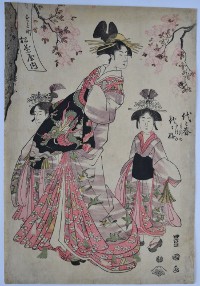
Click here to view image full size.
The elongated figure of the famous oiran Marino Yoyoharu parading with her kamuro Ikeno Yoyoume. Above, on a banner hanging from a tree, is the name and address of the courtesan’s location in the Yoshiwara: Sumimachi, Matsubaya uchi. Published by Tsuraya Juzaburo, c. 1796, Toyokuni’s best period. This courtesan was also depicted by Eisui and Utamaro and others around this date.
Fine impression and colour. Slight trimming and edge soil, otherwise good condition. Signed Toyokuni ga.
Status: Sold
Torii KIYOMITSU (1735-1785)
Click here to view image full size.
A large oban panel, 11.75 x 16.5 in; 29.75 x 42 cms showing three beauties playing, from the left, a shamisen, a koto, and a kokyu in an interior with hand-painted screens. A beautiful and important print. Kiyomitsu was the son and pupil of Kiyonobu II, the third of the Torii line and a prominent print designer. He pioneered the polychrome print which was brought to full fruition by Harunobu. Benizuri-e with beni, blue, yellow and green by superimposing blocks. Published by Kichi Uemura (Kichiemon of Emi-ya) c. 1764. There was a convention of printing three hosoban designs to a sheet from the 1720s to 1760s with a linking theme, in this case even though the image is signed three times it is as one. Exceptionally rare: The only other impression appears to be that in the Ritsumeikan University, Japan, Z 0165-424. An unread collector’s seal bottom right.
Fine impression and colour. Minor expertly restored areas, but in fine condition for a print of this size and date. Signed three times Torii Kiyomitsu ga.
Status: Sold
Kikugawa EIZAN (1787-1867)
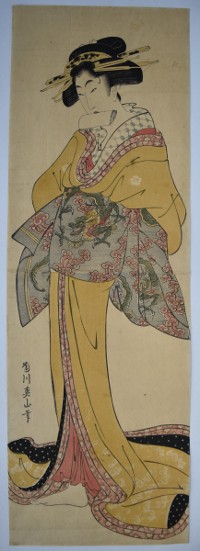
Click here to view image full size.
A vertican oban diptych showing a courtesan holding a letter between her teeth. This, and biting a towel, were considered highly erotic and the prelude to intimate relations. Her obi, which has a design of a dragon amongst clouds, is printed with extensive mica added to the grey ground.
Fine impression and colour. Minor marks, otherwise fine condition. Signed Kikugawa Eizan hitsu.
Status: Sold
Kesai EISEN (1790-1848)
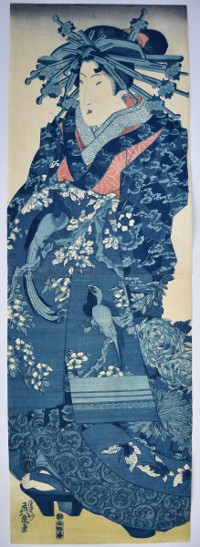
Click here to view image full size.
An aizuri-e vertical oban diptych with touches of red and green. A response to censorship bans which were promulgated to curtail excessive extravagance. (In this case the use of multiple blocks.) The bans were extended to the theatre and other areas that the Shogunate deemed to be susceptible to degeneration. Shows a sumptuously attired courtesan. Published by Sanoya Kihei, c. 1830s.
Superb impression: The cutting and printed of the block for the costume is of the highest order. Very fine colour and condition. Signed Kesai Eisen ga.
Status: Sold
Utagawa KUNISADA (1786-1864)
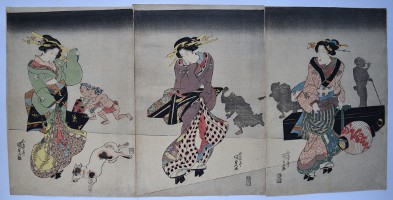
Click here to view image full size.
A triptych showing two beauties and a maidservant lighting their way with a lantern and carrying a shamisen box. The beam of light from the lantern illuminates the foreground figures and the leaping dog but leaves the background figures in silhouette. A lovely design. Another impression is illustrated in The Baur Collection, Matthi Forrer, 1994, volume 1, G266. Published by Mikawaya Seiemon, c. mid 1820s.
Fine impression and colour. Imperceptible fold, otherwise very good condition. Signed Gototei Kunisada ga.
Status: Sold
Utagawa TOYOKUNI II ( TOYOSHIGE ) (1777-1835)
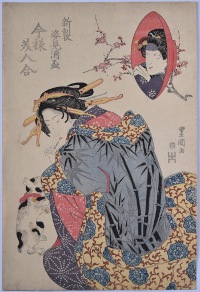
Click here to view image full size.
A courtesan with a toothpick and playing with a cat compared to the actor Iwai Hanshiro V ( inset in a sake cup top right ). From a series Imayo bijin awase, shinsei sugatami sakazuki, “A Comparison of Modern Beauties – A New Mirror of Sake Cups.” Published by Imariya Ushizo, c 1820-24.
Very good impression, colour and condition. Extensive mica added to the coat of the courtesan. Signed Toyokuni ga.
Status: Sold
Utagawa TOYOKUNI I (1769-1825)
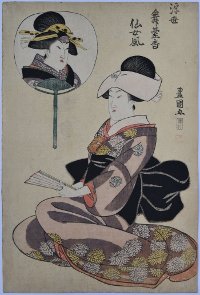
Click here to view image full size.
Shows a seated lady holding a fan compared to the actor Segawa Senjo ( previously known as Segawa Kikunojo III, inset in fan upper left ). From a series Ukiyo butai-ko Senjo-fu, “Fragrance from the Floating World’s Stage, in the Style of Senjo.” Published by Tsumuraya Saburobei, c 1810.
Fine impression. Light yellow ground. Very good colour and condition. Signed Toyokuni ga with an unidentified collector’s seal.
Status: Sold
Suzuki HARUNOBU (1725-1770)
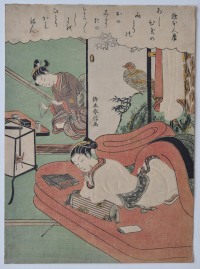
Click here to view image full size.
A chuban print from an untitled series showing a courtesan lying under a futon waiting for her kamuro to prepare her pipe in the adjoining room. A fusuma partially separates the two rooms and has a painting of a mountain pheasant on a craggy rock (alluded to in the poem above which is by Kakinomoto no Hitomaro, one of the famous Thirty-six Immortal Poets). This poem, which is also interpreted by Hokusai in his set One Hundred Poems Explained by the Nurse, is complex and speaks of long nights dragging by like a mountain trail or a pheasant’s tail. Published c 1768. A particularly rare Harunobu: Another impression is in the BM: A_1937-0710-0-18.
Fine impression with beautiful blind-printing delineating her body. The material hanging behind her is also gauffraged. Very good colour. Minor soil and signs of mounting au verso, otherwise very good condition. Signed on the fusuma Suzuki Harunobu ga.
Status: Sold
Torii KIYOMINE ( KIYOMITSU II ) (1787-1868)
Click here to view image full size.
Beauties on the beach at Kamakura with white cranes. This is an allusion or pastiche ( mitate ) of the story that Minamoto Yoritomo’s favourite amusement was flying cranes with labels attached to their legs requesting those who saw them to report the fact and fly them again. Kiyomine, a pupil of Kiyonaga, used – as here – the Kiyomine signature on his early work, c 1815. Published by Eijudo han ( Nishimura-ya ).
Very good impression and colour. Small area repaired wormage, otherwise very good condition. Signed Kiyomine ga.
Status: Sold
Suzuki HARUNOBU (1724-1770)
Click here to view image full size.
A chuban showing the courtesan Matsukaze of the Ogi-ya House from a set of prints: Ukiyo kika, “Strange Flowers of the Floating World.” Shows the courtesan parading outside a Yoshiwara house with her two kamuro. One of the most influential ukiyo-e artists taking full advantage of polychrome printing in 1765 and publishing a large number of exquisite prints, often with innovative pigments and on thick hosho. Published c late 1760s. Another impression in Yoshida, Harunobu zenshu, p. 128.
Fine impression. Slight fading otherwise very good condition. Signed Harunobu ga.
Status: Sold
Ikeda EISEN (1790-1848)
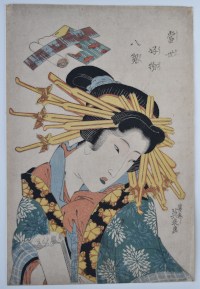
Click here to view image full size.
Decorative paper from a series Tosei kobutsu hakkei, “Eight Favourite Things in the Modern World.” The set compares beauties with their favourite “things.” In this case paper, shown top left, while other designs from the set compare beauties to dolls, playing cards, the theatre, kimono, etc. Shows a Yoshiwara courtesan holding a bundle of folded tissue. She has sasabeni lips: the lower lip painted with sasa from the bamboo plant, and the upper lip using beni from the safflower. Published by Senichi (Izumiya Ichibei), c 1823.
Fine impression. Slight fading and minor soil, otherwise very good condition. Signed Keisai Eisen ga.
Status: Sold
Utagawa KUNISADA (1786-1864)
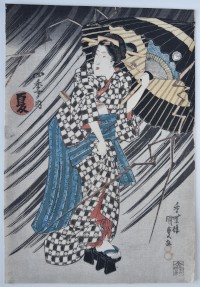
Click here to view image full size.
Natsu, “Summer” from a set f four prints Shii no ch “The Four Seasons.” A beauty holds a large umbrella against a summer storm with lightning flashing around her. Published by Kawaguchiya Uhei, c 1833-34.
Very good impression, colour and condition. Signed Kochoro Kunisada ga with double Toshidama seal (which is lacking on some impressions).
Status: Sold
Keisai EISEN (1790-1848)
Click here to view image full size.
An amorous couple on a balcony with a large full moon. One of the three best designs from a set of twelve prints: Keisei higo, “Secret Words of a Courtesan” published c 1822-25. Although the set comes under the shunga heading, each print is an abuna-e design, without any graphic detail. Fine composition.
Fine impression and colour. Laid onto board from the original album. Small wormage and slight centre fold ( as usual ), otherwise good condition.
Status: Sold
Kitagawa UTAMARO (1753-1806)
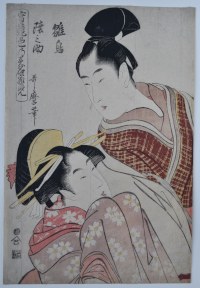
Click here to view image full size.
The lovers Hinadori and Kuganosuke from a series of half-length portraits of pairs of lovers featured in joruri love-suicide plays. (Joruri were bunraku puppet dramas). Jitsu kurabe iro no minakami, “True Feelings Compared: The Founts of Love.” At the height of their popularity the Japanese government cracked down on these joruri plays as they were inspiring copycat double suicides amongst the population. Published by Nishimuraya Yohachi, c 1798-9.
Fine impression. Very good colour. Some paper chain lines visible, otherwise very good condition. Signed Utamaro hitsu.
Status: Sold
Utagawa KUNIYOSHI (1797-1861)
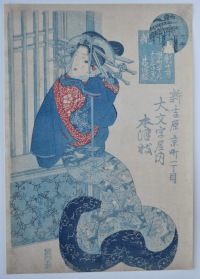
Click here to view image full size.
An aizuri-e print of the courtesan Hontsue of the Daimonjiya House in the Yoshiwara, Edo. Seated on a ledge, she holds an extremely long pipe and is compared to one of the sights of Edo: The Ryogoku Bridge. Published by Kawaguchiya Chozo, c 1830s.
Fine impression, colour and condition. Signed Ichiyusai Kuniyoshi ga.
Status: Sold
Keisai EISEN (1790-1848)
Click here to view image full size.
A winter scene with an amorous couple in a boat keeping warm beneath a huge duvet. One of the three best designs from a set of twelve prints: Keisei higo, “Secret Words of a Courtesan” published c 1822-25. Although the set comes under the shunga heading, each print is an abuna-e design, without any graphic detail.
Fine impression and colour. Laid onto board from the original album. Small wormage and slight centre fold ( as usual ), otherwise good condition.
Status: Sold
Utagawa KUNIYOSHI (1797-1861)
Click here to view image full size.
Women washing cloth in the Chofu River from a set of six triptychs of the Six Tama (or Jewel, or Crystal) Rivers. Musashi no kuni Chofu Tamagawa, “Chofu Crystal River in Musashi Province.” Published by Sanoya Kihei, 1847-8.
Very good impression, colour and condition. Signed Ichiyusai Kuniyoshi ga.
Status: Sold
Tsukioka YOSHITOSHI (1839-1892)
Click here to view image full size.
Spring from a set of triptychs Zensei shiki, “The Four Seasons at their Height.” (Actually, only three designs known.) Shows beauties enjoying an outing at the Risshun Plum Garden on the first day of spring at Hara village in the Ebara District. Published by Akiyama Buemon, 3/1884.
Superb impression of the first edition with de-luxe pigments; the red double-printed (lacking on later editions), blind-printing, burnishing, and beautiful bokashi. Fine colour and condition. Signed Oju Yoshitoshi hitsu.
Status: Sold
Tsukioka YOSHITOSHI (1839-1892)
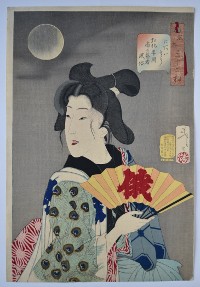
Click here to view image full size.
Niai-so: Koka nenkan kuruwa no geisha fuzoku, “Looking suitable: the appearance of a brothel geisha of the Koka era” (1844-1848). From the set Thirty-two Aspects of Women published by Tsunashima Kamekichi, 1888. Shows the beauty dressed as a fashionable young man.
Very fine impression of the first edition. Very fine colour with blind-printing and burnishing. Gold (brass powder) applied to the peacock design on the costume. This particular design from the set is notorious for having the brass degrade the paper and these areas fall out as well as offsetting onto the opposite print in album sets. Very fine condition. Signed Yoshitoshi ga.
Status: Sold
Ichiryusai HIROSHIGE (1797-1858)
Click here to view image full size.
Shows a beauty composing a letter from a set of ten prints Fukutoku gane no narikei, “Virtuous Women and the Money Tree.” Published by Aritaya Kiyoemon, c. 1847-50. The money tree branches make up the kanji characters of the sub-title, in this case Shuseki, the tree of good writing.
Very good impression, colour and condition. Signed Hiroshige ga.
Status: Sold
Katsukawa SHUN’EI (1762-1819)
Click here to view image full size.
A parading courtesan with her two kamuro. Published c. late 1790s by Murataya Jirobei (Eiyudo). Unsigned, but the manner of drawing the courtesan’s face is typical of Shun’ei. Interestingly, another unsigned print (with spurious Shunsho signature) but by Shun’ei is illustrated in The Actor’s Image, Clark & Ueda, A.I.C., 1994, no. 130, p. 346, and has the same publisher.
Very good impression and colour. Some small expertly restored wormage at left edge, otherwise very good condition.
Status: Sold
Keisai EISEN (1790-1848)
Click here to view image full size.
The courtesan Shiratama of the Sanomatsuya House in the Shin Yoshiwara seated looking into a mirror. Episode Sekidera from a Seven Komachi set: Shin Yoshiwara yugimi nana Komachi. The set based on the seven episodes in the life of the famous 9th century poetess Ono no Komachi. Published by Tsuta-ya, c 1830.
Very good impression of the first state. Superb, unfaded colour. Fine condition; full size. Signed Kei
Status: Sold
Keisai EISEN (1790-1848)
Click here to view image full size.
The courtesan Efuku of the Owariya House in the Shin Yoshiwara seated at a low desk and holding a toothpick. Episode Kiyomidzu from a Seven Komachi set: Shin Yoshiwara yugimi nana Komachi. The set based on the seven episodes in the life of the famous 9th century poetess Ono no Komachi. Published by Tsuta-ya, c 1830.
Very good impression of the first state. Superb, unfaded colour. Fine condition; full size. Signed Keisai Eisen ga.
Status: Sold
